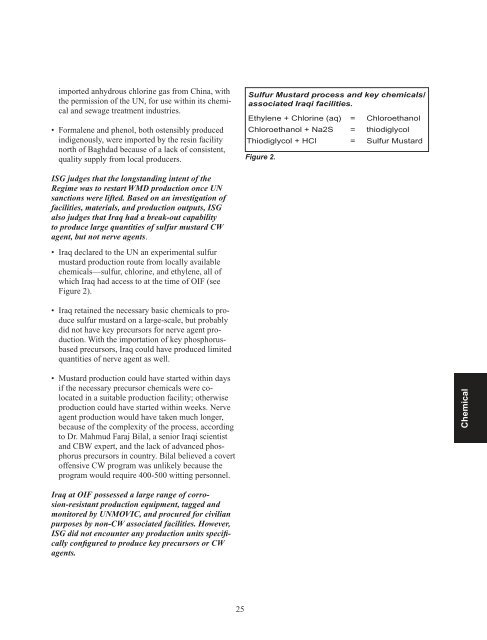Comprehensive Report
GPO-DUELFERREPORT-3
GPO-DUELFERREPORT-3
- No tags were found...
You also want an ePaper? Increase the reach of your titles
YUMPU automatically turns print PDFs into web optimized ePapers that Google loves.
imported anhydrous chlorine gas from China, with<br />
the permission of the UN, for use within its chemical<br />
and sewage treatment industries.<br />
• Formalene and phenol, both ostensibly produced<br />
indigenously, were imported by the resin facility<br />
north of Baghdad because of a lack of consistent,<br />
quality supply from local producers.<br />
Sulfur Mustard process and key chemicals/<br />
associated Iraqi facilities.<br />
Ethylene + Chlorine (aq) = Chloroethanol<br />
Chloroethanol + Na2S = thiodiglycol<br />
Thiodiglycol + HCl = Sulfur Mustard<br />
Figure 2.<br />
ISG judges that the longstanding intent of the<br />
Regime was to restart WMD production once UN<br />
sanctions were lifted. Based on an investigation of<br />
facilities, materials, and production outputs, ISG<br />
also judges that Iraq had a break-out capability<br />
to produce large quantities of sulfur mustard CW<br />
agent, but not nerve agents.<br />
• Iraq declared to the UN an experimental sulfur<br />
mustard production route from locally available<br />
chemicals—sulfur, chlorine, and ethylene, all of<br />
which Iraq had access to at the time of OIF (see<br />
Figure 2).<br />
• Iraq retained the necessary basic chemicals to produce<br />
sulfur mustard on a large-scale, but probably<br />
did not have key precursors for nerve agent production.<br />
With the importation of key phosphorusbased<br />
precursors, Iraq could have produced limited<br />
quantities of nerve agent as well.<br />
• Mustard production could have started within days<br />
if the necessary precursor chemicals were colocated<br />
in a suitable production facility; otherwise<br />
production could have started within weeks. Nerve<br />
agent production would have taken much longer,<br />
because of the complexity of the process, according<br />
to Dr. Mahmud Faraj Bilal, a senior Iraqi scientist<br />
and CBW expert, and the lack of advanced phosphorus<br />
precursors in country. Bilal believed a covert<br />
offensive CW program was unlikely because the<br />
program would require 400-500 witting personnel.<br />
Chemical<br />
Iraq at OIF possessed a large range of corrosion-resistant<br />
production equipment, tagged and<br />
monitored by UNMOVIC, and procured for civilian<br />
purposes by non-CW associated facilities. However,<br />
ISG did not encounter any production units specifically<br />
configured to produce key precursors or CW<br />
agents.<br />
25


